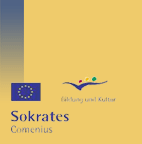|
Preparation:
Round beer mats, paper, scissors, coloured pencils, wax crayons, short
pins with thick heads, fast drying adhesive, a beer mat with a hole in the
centre as template.
(Paint brush, water colours, water, crepe for the variation)
|
Steps:
· cut out a
circle of white paper the same size as the beer mat. Glue the piece of paper
on to the beer mat and colour it
· stick a
needle into the centre of the beer mat
· turn the
spinning top and watch the result
· experiment
with different colours and patterns
|
|
Scientific Explanation:
When the spinning top moves fast, the eye cannot distinguish the
individual colours and patterns. That is why the patterns and the colours
become blurred and mix.
At a certain speed the pictures join up to produce a movement (film).
Experimenting with a potters wheel and liquid paint also makes
experiences with centrifugal force possible.
|
Possible Variation:
Instead of the beer mats, a potters wheel is covered with an
adequately large sheet of paper. While the wheel is turning the children
apply colours onto the sheet, they keep the paintbrush upright. The children
examine how patterns develop, what happens if two or more colours meet, what
effect the pressure on the brush has. They compare how a dot or a line looks
when the wheel stands still or when it is turning.
|











